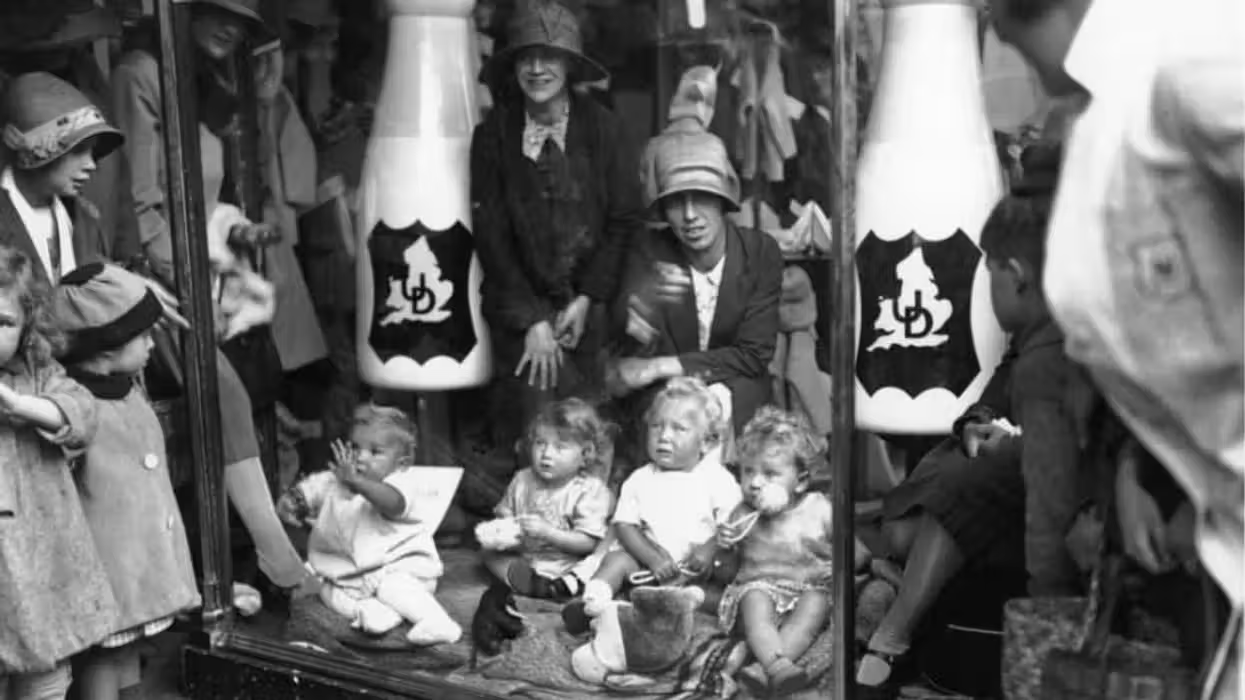While much of the scientific world relies on text-heavy journal articles, there's a special place for the images that can show science much more elegantly without words.
The National Science Foundation with the journal Science announced Thursday the winners of its 11th annual International Science & Engineering Visualization Challenge, showing what the foundation called some of the most "powerful scientific concepts."
"We were delighted by this year's entries. These visualizations are both beautiful and captivating; they connect scientists with citizens in a way that excites popular interest of subjects normally reserved for academic rigor," Judith Gan, the foundation's director of legislative and public affairs, said in a statement.
In categories ranging from photography to video to apps, the challenge received 227 submissions from 12 countries. Winners were chosen by a panel, but nearly 2,000 votes were cast for the people's choice awardees as well.
"The winners offer a feast for the eye and the mind, making complex science vivid and beautiful," Science news editor Tim Appenzeller said in a statement.
Here are several category winners (ordered from first place, honorable mention and people's choice):
Photography
 Invisible Coral Flows reveal the hidden flow generated by small hairs (cilia) covering the surface of the coral, between two coral polyps that are 3 mm apart. Two shots taken 1.5 hours apart are combined into a single image, showing how the coral is able to create a long-lasting whirlpool structure that alters the local environment and enhances the coral's ability to "breathe." (Caption via Mark Peplow/Science, Photo credit: NSF/Vicente I. Fernandez, Orr H. Shapiro, Melissa S. Garren, Assaf Vardi and Roman Stocker, Massachusetts Institute of Technology )
Invisible Coral Flows reveal the hidden flow generated by small hairs (cilia) covering the surface of the coral, between two coral polyps that are 3 mm apart. Two shots taken 1.5 hours apart are combined into a single image, showing how the coral is able to create a long-lasting whirlpool structure that alters the local environment and enhances the coral's ability to "breathe." (Caption via Mark Peplow/Science, Photo credit: NSF/Vicente I. Fernandez, Orr H. Shapiro, Melissa S. Garren, Assaf Vardi and Roman Stocker, Massachusetts Institute of Technology )
 These exuberant starbursts shoot from the leaves of Deutzia scabra, a deciduous shrub sometimes known as "Pride of Rochester." Its leaves are covered with tiny hairs tipped by stars a quarter-millimeter across, giving it a fuzzy texture that Japanese woodworkers sometimes use for fine polishing. (Caption via Mark Peplow/Science; Photo credit: NSF/Stephen Francis Lowry, Steve Lowry Photography )
These exuberant starbursts shoot from the leaves of Deutzia scabra, a deciduous shrub sometimes known as "Pride of Rochester." Its leaves are covered with tiny hairs tipped by stars a quarter-millimeter across, giving it a fuzzy texture that Japanese woodworkers sometimes use for fine polishing. (Caption via Mark Peplow/Science; Photo credit: NSF/Stephen Francis Lowry, Steve Lowry Photography )
 This image demonstrates results of the study of micro-structure formation in polymers that self-assemble into different shapes ranging from grains to lines interconnected into complex patterns and meshes. It shows the microstructure of a 2-millimeter-long fragment of self-assembled polymers, which University of South Florida materials scientist Anna Pyayt is using to build miniature "lab-on-a-chip" devices for biomedical diagnostic applications. (Caption via Mark Peplow/Science; Photo credit: NSF/Anna Pyayt and Howard Kaplan, University of South Florida)
This image demonstrates results of the study of micro-structure formation in polymers that self-assemble into different shapes ranging from grains to lines interconnected into complex patterns and meshes. It shows the microstructure of a 2-millimeter-long fragment of self-assembled polymers, which University of South Florida materials scientist Anna Pyayt is using to build miniature "lab-on-a-chip" devices for biomedical diagnostic applications. (Caption via Mark Peplow/Science; Photo credit: NSF/Anna Pyayt and Howard Kaplan, University of South Florida)
Illustrations
 Cortex in Metallic Pastels represents a stylized section of the cerebral cortex, in which axons, dendrites, and other features create a scene reminiscent of a copse of silver birch at twilight. An accurate depiction of a slice of cerebral cortex would be a confusing mess, says illustrator Greg Dunn, so he thins out the forest of cells, revealing the delicate branching structure of each neuron. Dunn combined his background in neuroscience and his love of Asian art, to create the sparse, striking illustrations of the brain. (Caption via Mark Peplow/Science; Image credit: NSF/Greg Dunn, Greg Dunn Design)
Cortex in Metallic Pastels represents a stylized section of the cerebral cortex, in which axons, dendrites, and other features create a scene reminiscent of a copse of silver birch at twilight. An accurate depiction of a slice of cerebral cortex would be a confusing mess, says illustrator Greg Dunn, so he thins out the forest of cells, revealing the delicate branching structure of each neuron. Dunn combined his background in neuroscience and his love of Asian art, to create the sparse, striking illustrations of the brain. (Caption via Mark Peplow/Science; Image credit: NSF/Greg Dunn, Greg Dunn Design)
 Security Blanket displays a multicolored "word cloud" of the 1000 most common passwords in the social gaming website, RockYou. The passwords were sized according to their frequency and colored according to their theme. The most common--"123456"--was chosen by three times as many people as the next most popular password. (Caption via Mark Peplow/Science; Image credit: NSF/Lorrie Faith Cranor, Carnegie Mellon University)
Security Blanket displays a multicolored "word cloud" of the 1000 most common passwords in the social gaming website, RockYou. The passwords were sized according to their frequency and colored according to their theme. The most common--"123456"--was chosen by three times as many people as the next most popular password. (Caption via Mark Peplow/Science; Image credit: NSF/Lorrie Faith Cranor, Carnegie Mellon University)
 In our war against bacteria, the microbes are winning. That somber message is writ large in this image of a human hand covered with Pseudomonas bacteria. Those colored green are resistant to antimicrobial treatment--only a rare few are red, indicating that they have been vanquished. (Caption via Mark Peplow/Science; Image credit: NSF/Lydia-Marie Joubert, Stanford University)
In our war against bacteria, the microbes are winning. That somber message is writ large in this image of a human hand covered with Pseudomonas bacteria. Those colored green are resistant to antimicrobial treatment--only a rare few are red, indicating that they have been vanquished. (Caption via Mark Peplow/Science; Image credit: NSF/Lydia-Marie Joubert, Stanford University)
First-Place Video
The first-place video went to NASA's Greg Shirah and Horace Mitchell. Their video shows a coronal mass ejection and ocean and wind circulation patterns on Earth. Check it out:
"It's one of the top visualizations we've ever done," Mitchell with NASA's Scientific Visualization Studio said, according to NSF.
Check out more winners in the various categories on the award's website. Science has more information about the winners.
(H/T: Gizmodo)

 Invisible Coral Flows reveal the hidden flow generated by small hairs (cilia) covering the surface of the coral, between two coral polyps that are 3 mm apart. Two shots taken 1.5 hours apart are combined into a single image, showing how the coral is able to create a long-lasting whirlpool structure that alters the local environment and enhances the coral's ability to "breathe." (Caption via Mark Peplow/Science, Photo credit: NSF/Vicente I. Fernandez, Orr H. Shapiro, Melissa S. Garren, Assaf Vardi and Roman Stocker, Massachusetts Institute of
Invisible Coral Flows reveal the hidden flow generated by small hairs (cilia) covering the surface of the coral, between two coral polyps that are 3 mm apart. Two shots taken 1.5 hours apart are combined into a single image, showing how the coral is able to create a long-lasting whirlpool structure that alters the local environment and enhances the coral's ability to "breathe." (Caption via Mark Peplow/Science, Photo credit: NSF/Vicente I. Fernandez, Orr H. Shapiro, Melissa S. Garren, Assaf Vardi and Roman Stocker, Massachusetts Institute of 




